Enter the Void Blu-ray Movie
HomeEnter the Void Blu-ray Movie 
Full-Length Director's CutMPI Media Group | 2009 | 161 min | Not rated | Jan 25, 2011
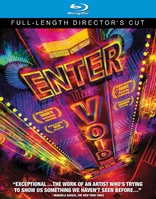
Price
List price:Third party: $23.06 (Save 23%)
Listed on Amazon marketplace
Buy it from YesAsia:
Movie rating
7.5 | / 10 |
Blu-ray rating
| Users | 3.8 | |
| Reviewer | 4.0 | |
| Overall | 3.9 |
Overview
Enter the Void (2009)
The story of a young man, Oscar, who after the brutal death of his parents, makes a promise to his sister never to leave her, no matter what, but is killed at the hands of corrupt police.
Starring: Nathaniel Brown (I), Paz de la Huerta, Cyril Roy, Emily Alyn Lind, Jesse KuhnDirector: Gaspar Noé
| Drama | 100% |
| Psychological thriller | 37% |
| Surreal | 34% |
| Erotic | 18% |
| Thriller | Insignificant |
Specifications
Video
Video codec: MPEG-4 AVC
Video resolution: 1080p
Aspect ratio: 2.34:1
Original aspect ratio: 2.39:1
Audio
English: DTS-HD Master Audio 5.1 (48kHz, 24-bit)
English: LPCM 2.0 (48kHz, 24-bit)
Subtitles
English SDH, Spanish
Discs
50GB Blu-ray Disc
Single disc (1 BD)
Playback
Region A (locked)
Review
Rating summary
| Movie | 4.5 | |
| Video | 4.0 | |
| Audio | 4.0 | |
| Extras | 2.0 | |
| Overall | 4.0 |
Enter the Void Blu-ray Movie Review
The 2011 Blu-ray release most likely to induce seizures.
Reviewed by Casey Broadwater February 2, 2011Finally, a film to unseat Jacob’s Ladder as my favorite movie loosely based on the Bardo Thodal, otherwise known as “The Tibetan Book of the Dead.” In Enter the Void, French-Argentine director/provocateur Gaspar Noé—best known for his controversial reverse-order rape revenge thriller Irreversible—takes us on a hallucinogenic, 2001: A Space Odyssey-inspired mind-trip that follows a disembodied soul through the various intermediary stages between death and reincarnation. As a premise, it’s staggeringly ambitious, but Noé makes good with some of the most invigoratingly rule-breaking, purely visual filmmaking in recent memory. There will inevitably be those who will watch this film while stoned, and I wish these people a speedy recovery from the mental trauma to which they’re about to subject themselves. Enter the Void is no flowery, happy high; it’s a dark, nihilistic excursion through the bowels of the subconscious. Even the title sounds like a dare most would rather not take. Still, for those adventurous enough to Enter the Void—and not back out midway through—a haunting, unprecedented movie-watching experience awaits.
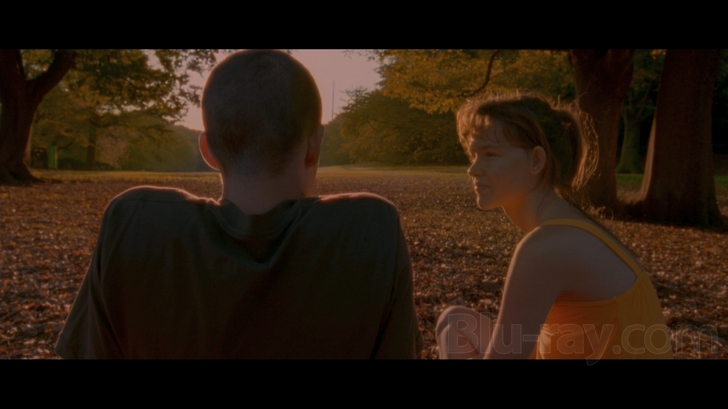
Nathaniel Brown and Paz de la Huerta
The setting is Roppongi, the neon-lit nightlife district of Tokyo, where gaijin drug dealer Oscar (newcomer Nathaniel Brown) shares a cramped studio apartment with his sister Linda (Boardwalk Empire’s Paz de la Huerta), a topless dancer at a nearby club. The entire film is shown from Oscar’s perspective—via first-person camerawork—so we rarely ever see his face. Rather, we see directly through his eyes—the image even “blinks” when Oscar does—a technique that’s intimate and occasionally disorienting. After Linda leaves for work, Oscar sits down to blaze up some DMT, a drug that supposedly contains the same chemical that the brain releases at death. His vision floods with flickering lights and when he lays back and looks up, amorphous fractal-like patterns with pulsating, serpentine tendrils appear on the ceiling. This unsettling vision is interrupted by a phone call. It’s Victor (Olly Alexander), one of Oscar’s regular customers, who wants to meet at a bar called, yes, The Void, to make a deal. On his way over, Oscar is joined by his friend/mentor Alex (Cyril Roy), an artist who recently lent him a paperback copy of The Tibetan Book of the Dead. Little does Oscar know that he’ll soon become intimately acquainted with the book’s precepts. When he enters the bar, he quickly realizes Victor has sold him out to the Japanese cops. Oscar barricades himself in the bar’s dingy restroom and, to buy himself time to flush his drugs down the toilet, yells that he has a gun. Bad move. A bullet rips suddenly through his chest and he falls to the floor. His spirit, soul, consciousness—whatever you want to call it—rises up through the ceiling, looking down on what is now the husk of his body.
All this, mind you, occurs in the first 30 minutes of the 161-minute Director’s Cut that we get here. (There’s no option on the disc to view the shorter, 142-minute version.) For the remainder of the film, Oscar’s spirit floats and flashes over Tokyo—using some devilishly complex crane shots —passing through buildings, peering down at the events unfolding below, and jumping back, not unlike Irreversible, to the lifelong series of turning points that led up to his death. Through these flash before your eyes sequences, a narrative slowly begins to emerge. We observe Oscar and Linda as kids, swearing a blood oath to never leave one another, and witness the jolting death of their parents in a head-on collision with an 18-wheeler. (An image Noé returns to often—and it’s shocking every time.) In the more recent past, we see Oscar’s descent into drug dealing and piece together the motivation for Victor’s betrayal. At the core of the story, though, is the quasi-incestuous, mutually dependant relationship between Oscar and his sister, who seems so innocent upon arrival at Narita Airport—she carries a teddy bear around with her everywhere—but soon finds herself nuzzled up against the city’s seamy underbelly, personified by her pimp/employer/lover Mario (Masato Tanno). When the film works its way back to the present, Oscar—or his soul, rather—fulfills his childhood promise by watching over Linda as she scrambles to survive in Tokyo after his death. I won’t spoil the details of Oscar’s inevitable reincarnation, except to say that it involves a series of erotic vignettes in a love hotel, Oscar mind-jacking his friend Alex mid-coitus with Linda, and an ejaculatory, never-before-seen money shot that intrepid porn producers will undoubtedly soon be trying to reproduce.
In the press kit for Enter the Void, Noé describes the film’s central theme as the “sentimentality of mammals and the shimmering vacuity of human experience,” a statement that seems entirely pompous but one that also provides a key for a more complete understanding of the director’s bleakly existential intent. For Noé, The Void is life itself—not just the non-existent hereafter—and Oscar’s out-of-body journey from death to reincarnation can be read as the split second delusion of a junkie, high off his own supply, facing the nothingness of what comes next. A harsh buzz, indeed. As for the “sentimentality of mammals,” Noé fills his film with Freudian images of breasts—a symbol of human connectivity—from baby Oscar sucking at his mother’s teat to Linda, hyper-sexualized, lounging around the apartment with no shirt on, flaunting what she’s got in full view of her brother. (Between this and her sex-cat turn as Nucky Thompson’s mistress in Boardwalk Empire, I feel like I’m strangely familiar with the details of Paz de la Huerta’s anatomy.) Noé seems to be pointing out what he sees as the inherent sadness of how we attach significance to human connections that are essentially—in the long run—objectively meaningless. Sex, drugs, relationships…all are merely futile attempts to escape the looming threat of death.
Of course, Noé is not the first filmmaker to tackle this particular philosophical dilemma, but he is perhaps one of the most audacious, at least stylistically. (If not in content. I occasionally get the sense that Noé gets his own personal high off of being perceived as “shocking.” Amongst all the full-on nudity and graphic sex, there’s also a lingering view of an aborted fetus that will likely provoke a fight-or-flight response in viewers.) As an aesthetic experiment, Enter the Void is an unconventional and unsettling success. Other filmmakers have tried first-person narration before, but never to the extent or effectiveness with which it’s used here. Although watching the film is an exhausting experience—this is a long 161 minutes of having your senses almost constantly assaulted—you emerge on the other side with the satisfying awareness that you’ve just seen something new. And that’s a rare feeling when most movies at the multiplex are sequels, rehashes, or updates on old forms.
Enter the Void Blu-ray Movie, Video Quality 
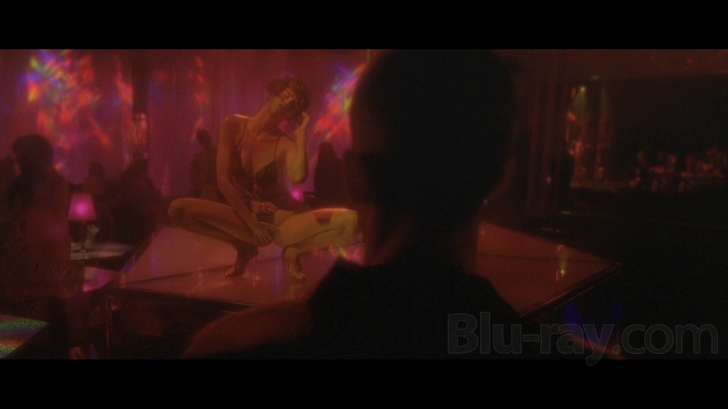
Enter the Void is a film that has to be accepted on its on terms, and that goes for the film's 1080p/AVC-encoded transfer as well. For all its visual power, this is a rough-looking image at times, one that rarely adheres to the traits that videophiles look for in a "reference level" picture. With the exception of the scenes at the beginning when Oscar is still alive, which were shot in the Super 35mm format, most of the film was shot on 16mm, resulting in an image with a chunkier grain structure and less inherent analog resolution. You also have to consider the fact that every frame in the film features some sort of digital tweaking; selective focus was achieved by blurring the outer edges of the picture, warps and flickers and strobes of color were intentionally introduced in post, and there are whole scenes where the backgrounds are almost entirely—and believably, I should add— constructed in CGI. The image, then, while obviously in high definition, is often simultaneously soft and grimy, with thick swarms of heavy grain and a distinct lack of truly fine detail. Still, this was how the film was shot and processed, and you have to respect that. All that said, colors are quite strong— especially in the hallucination sequences—and the picture is ugly in an aesthetically attractive way, if that makes sense. As for encode issues, it's hard to look for digital noise amongst the heavy grain, but I did notice a few slight signs of compression, like mild banding in one of the aerial ascents over Tokyo. Nothing major though. The picture is probably as close to how it's supposed to look as possible.
Enter the Void Blu-ray Movie, Audio Quality 
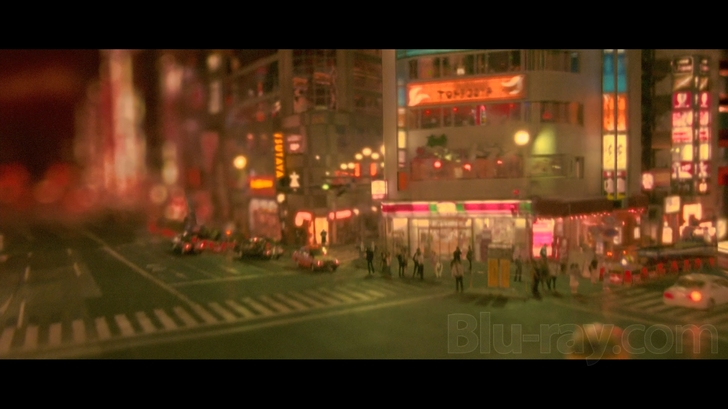
Likewise, Enter the Void's DTS-HD Master Audio 5.1 surround track often seems far from high fidelity, but it certainly infuses the film with the required sense of dread. If you turn on the English SDH subtitles, you're guaranteed to see lots of descriptions like "ominous droning." Most of the film is a combination of hushed, unsettling ambience and deep, filtered club music, the kick drum frequently activating the LFE channel. The rear speakers aren't used as often as you might expect—given how otherwise immersive the film is—but you'll hear occasional cross channel movements and directional sounds, like a bottle breaking in the space behind your head, phaser noises circling the soundfield, or a high-pitched tinnitus hum. Oh, and then there's the extremely loud car crash, which always managed to give me a good jolt, even when I saw it coming. Dialogue isn't always crystal clear, but I don't think complete intelligibility was Noé's intent. No complaints here. English SDH and Spanish subtitles are available in easy-to-read yellow lettering that partially covers the 2.34:1 frame.
Enter the Void Blu-ray Movie, Special Features and Extras 
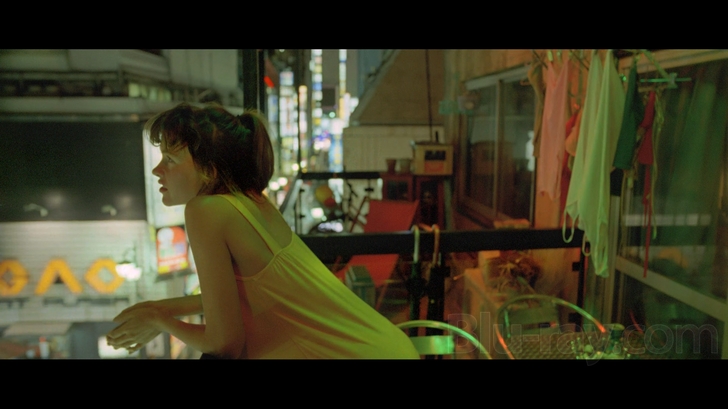
While I would've loved a comprehensive making-of documentary or an audio commentary by the director, all we get here are some deleted scenes, a before-and-after visual effects featurette, a collection of trailers, a poster gallery, and loops of two hallucinogenic sequences.
- Deleted Scenes (1080p, 12:00): There are eight deleted/extended scenes here, including a creepy first-person trip through a sewer tunnel, lit only by a cigarette lighter.
- Teasers (1080p, 7:11): Several provocative teaser trailers for the film.
- Trailers (1080p, 3:22): Includes the French and World trailers of the film.
- U.S. Trailer (1080p, 2:08): Not sure why this one isn't grouped with the others, but anyway...
- Unused Trailers (1080p, 5:20)
- VFX (1080p, 11:09): I wish this was an in-depth profile of how some of the special effects shots were created, but it's really just an extended demo reel of before and after shots, set to music from the film.
- Vortex (1080p, 5:32): You know those "visualizers" you can turn on in iTunes or Windows Media Player? This is like the best one ever.
- DMT Loop (1080p, 2:11): Wanna watch the DMT sequence on repeat for, um, recreational purposes?
- Posters (1080p): A user controlled gallery with 23 posters.
Enter the Void Blu-ray Movie, Overall Score and Recommendation 
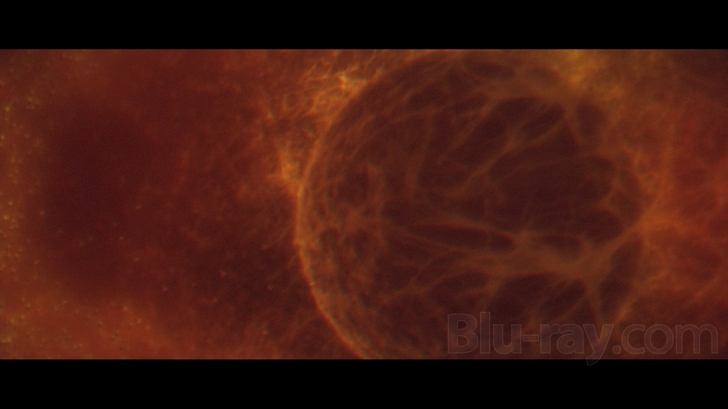
Epileptics, pregnant women, and the easily shocked or offended should probably avoid Gaspar Noé's flickering vision of what dreams may come—which earns its NC-17 rating and then some—but those willing to give in to the director's hallucinatory excesses will find Enter the Void inescapably mesmerizing. Highly recommended!
Similar titles
Similar titles you might also like

Eyes Wide Shut
1999

Repulsion
1965

Love 3D
2015

Antichrist
2009

Nymphomaniac: Volume I
2013

Nymphomaniac: Volume II
2013

Shame
2011

We Need to Talk About Kevin
2011

Babel
2006

Wake in Fright
1971

Marnie 4K
1964

Belle de jour
1967

The Night of the Hunter 4K
1955

Mulholland Drive
2001

Under the Skin
2013

Paris, Texas
1984

Crash
1996

Tom at the Farm
Tom à la ferme / English packaging / Version française
2013

Black Swan
2010

Sex, Lies, and Videotape
1989